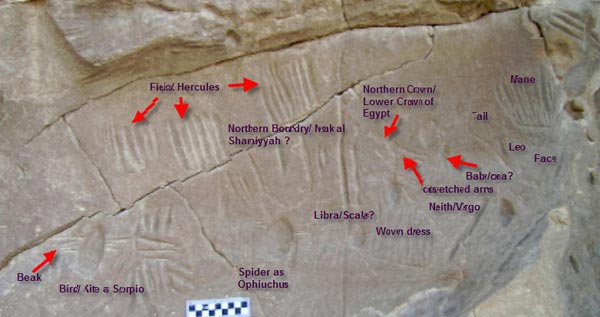Could Kharga Oasis Rock Panel Represent Zodiacal Constellations?
Two weeks ago, Egyptologist Salima Ikram announced the discovery of a very unusual rock panel in the Kharga Oasis, 175 kilometres west of Luxor in Egypt. While the date of the panel is still uncertain, it is thought to go back to prehistoric times, at least 4,000 BC or earlier. Ikram claimed the rock art is a depiction of spiders, webs, and insects trapped by spiders, and this is the theory that has dominated mainstream news reporting.
However, here at Ancient-Origins, we are interesting in exploring alternative perspectives. Dr Derek Cunningham, author of ‘400,000 Years of Stone Age Science’ has suggested that the linear comb patterns are in fact an archaic form of astronomical writing. Now we present an opinion piece by Michael Ledo, author of ‘On Earth as it is in Heaven: The Cosmic Roots of the Bible’, among other works, who provides another interpretation of this unusual rock panel.
-------------------------------------------------------------------------------------------------------------------------------------
As someone who sees astrological symbols in everything ancient, I have found the new "spider rock" discovery easy to decipher. The four bottom figures represent four zodiacal constellations. In 4,000 BCE these would represent roughly the months of May June July and August. However, in today's calendar they are July, August, September, and October.
The figure on the far left is not a spider. It has a beak clearly pointing to the left. This is a bird. In ancient times the constellation Scorpio was represented by a bird, typically an eagle. This is seen in the Bible in the vision of Ezekiel: "Each of the four had the face of a human being, and on the right side each had the face of a lion, and on the left the face of an ox; each also had the face of an eagle." These represented the four signs that denoted the solstices and equinoxes (Aquarius, Leo, Taurus, and Scorpio.)
The second figure from the left that looks like a spider, is a spider. This was sometimes used to represent Ophiuchus which has been called the 13th zodiac symbol. Libra, as a scale comes to us from the Greeks via Babylon. Libra was once part of Scorpio, representing its claws. This area of space was subject to different interpretations.
The third figure is the most important. It is an early representation of Neith in Virgo. The thatched area, mistaken for another spider is actually a woven skirt. She is sitting holding something in her out stretched arms, most likely grain stalks. Her headdress is clearly the spiral of Lower Egypt. This represented the constellation of the Northern Crown. (Lower Egypt is north). The curl in the red crown represents the umbilical cord. The ancient symbol for the womb was the maze due to the umbilical cord. In Greek Mythology, the constellation of the Northern Crown represented the story of Theseus using a ball of thread to escape from the labyrinth. In the Old Testament, it represents the story of Tamar who used a red thread to tie the hand of the twin that first appeared from the womb.
The fourth "spider" on the far right, almost off the rock, is the mane of the lion Leo. The eyes and a crudely drawn face, looking like refrigerator art, is clearly seen. It is possible Neith is holding his tail instead of wheat. That area is unclear.
The thatched marks above the crack in the upper left is about where the constellation Hercules would go. I had originally believed this had to do with the rising sun, but I believe I am guilty of an ancient anachronism. The thatched boxes are fields, most likely crop fields. In ancient times the constellations of Ophiuchus and Hercules represented pasture land. The rock appears to be coincidentally cracked at what was an astronomical dividing line between the lands.
There is a theme in the rock in that three of the symbols (Neith, Spider, Fields) represents the manufacture of woven material as associated with the goddess.
By Michael Ledo




















Comments
Amazing discovery